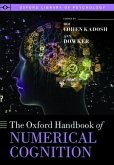Oxford Handbook of Hypnosis
Theory, Research and Practice
Herausgeber: Barnier, Amanda J; Nash, Michael R
Oxford Handbook of Hypnosis
Theory, Research and Practice
Herausgeber: Barnier, Amanda J; Nash, Michael R
- Broschiertes Buch
- Merkliste
- Auf die Merkliste
- Bewerten Bewerten
- Teilen
- Produkt teilen
- Produkterinnerung
- Produkterinnerung
The Oxford Handbook of Hypnosis is the successor to Fromm and Nash's Contemporary Hypnosis Research (Guilford Press), which has been regarded as the field's authoritative scholarly reference for over 35 years. For postgraduates, researchers, and clinicians, this book is the definitive reference text in the field.
Andere Kunden interessierten sich auch für
![The Oxford Handbook of Attention The Oxford Handbook of Attention]() The Oxford Handbook of Attention83,99 €
The Oxford Handbook of Attention83,99 €![The Oxford Handbook of Music and the Brain The Oxford Handbook of Music and the Brain]() The Oxford Handbook of Music and the Brain75,99 €
The Oxford Handbook of Music and the Brain75,99 €![The Oxford Handbook of Neuroethics The Oxford Handbook of Neuroethics]() The Oxford Handbook of Neuroethics137,99 €
The Oxford Handbook of Neuroethics137,99 €![The Oxford Handbook of the Five Factor Model The Oxford Handbook of the Five Factor Model]() The Oxford Handbook of the Five Factor Model237,99 €
The Oxford Handbook of the Five Factor Model237,99 €![The Oxford Handbook of Cyberpsychology The Oxford Handbook of Cyberpsychology]() The Oxford Handbook of Cyberpsychology74,99 €
The Oxford Handbook of Cyberpsychology74,99 €![The Oxford Handbook of Numerical Cognition The Oxford Handbook of Numerical Cognition]() The Oxford Handbook of Numerical Cognition104,99 €
The Oxford Handbook of Numerical Cognition104,99 €![Oxford Handbook of Identity Development Oxford Handbook of Identity Development]() Oxford Handbook of Identity Development82,99 €
Oxford Handbook of Identity Development82,99 €-
-
-
The Oxford Handbook of Hypnosis is the successor to Fromm and Nash's Contemporary Hypnosis Research (Guilford Press), which has been regarded as the field's authoritative scholarly reference for over 35 years. For postgraduates, researchers, and clinicians, this book is the definitive reference text in the field.
Hinweis: Dieser Artikel kann nur an eine deutsche Lieferadresse ausgeliefert werden.
Hinweis: Dieser Artikel kann nur an eine deutsche Lieferadresse ausgeliefert werden.
Produktdetails
- Produktdetails
- Oxford Library of Psychology
- Verlag: Oxford University Press
- Seitenzahl: 802
- Erscheinungstermin: 19. Januar 2012
- Englisch
- Abmessung: 244mm x 170mm x 43mm
- Gewicht: 1418g
- ISBN-13: 9780199645800
- ISBN-10: 0199645809
- Artikelnr.: 38478423
- Herstellerkennzeichnung
- Libri GmbH
- Europaallee 1
- 36244 Bad Hersfeld
- gpsr@libri.de
- Oxford Library of Psychology
- Verlag: Oxford University Press
- Seitenzahl: 802
- Erscheinungstermin: 19. Januar 2012
- Englisch
- Abmessung: 244mm x 170mm x 43mm
- Gewicht: 1418g
- ISBN-13: 9780199645800
- ISBN-10: 0199645809
- Artikelnr.: 38478423
- Herstellerkennzeichnung
- Libri GmbH
- Europaallee 1
- 36244 Bad Hersfeld
- gpsr@libri.de
Mike Nash is one the world's leading experts on hypnosis. He is a prolific researcher and clinical educator, who also maintains an active clinical practice. He is Professor of Psychology at the University of Tennessee, and is Editor Emeritus of The International Journal of Clinical and Experimental Hypnosis, the world's premiere venue for scientific and applied hypnosis. He received his Ph.D. from Ohio University in 1983 and completed his clinical internship at Yale University School of Medicine Department of Psychiatry in the same year. He has published two books, one on the research foundations of hypnosis and another on integrating hypnosis into clinical practice. He is a Diplomate in Clinical Psychology (ABPP), and is the recipient of 18 national and international awards for his scientific, clinical, and teachng accomplishments. Amanda Barnier is an Associate Professor and Australian Research Council (ARC) Australian Research Fellow in the Macquarie Centre for Cognitive Science, Macquarie University, Sydney, Australia. Amanda began her career in Psychology at Macquarie University, graduating in 1991 with a BA(Hons). She completed a PhD in Psychology (1996) at the University of New South Wales (UNSW), and postdoctoral work at the University of California, Berkeley. Amanda then returned to Australia and UNSW as an ARC Postdoctoral Fellow and later as an ARC Queen Elizabeth II Fellow. She returned to Macquarie University in 2007.
* 1: Amanda J. Barnier and Michael R. Nash: Introduction: a roadmap for
explanation, a working definition
* Section I: Domain of hypnosis
* 2: John F. Kihlstrom: The domain of hypnosis, revisited
* 3: Kevin M. McConkey: Generations and landscapes of hypnosis:
questions we've asked, questions we should ask
* Section II: Theoretical perspectives
* 4: Erik Z. Woody and Pamela Sadler: Dissociation theories of hypnosis
* 5: Steven Jay Lynn, Irving Kirsch and Michael N. Hallquist: Social
cognitive theories of hypnosis
* 6: Amanda J. Barnier, Zoltan Dienes and Chris J. Mitchell: How
hypnosis happens: new cognitive theories of hypnotic responding
* 7: David Spiegel: Intelligent design or designed intelligence?
Hypnotizability as neurobiological adaptation
* 8: Michael R. Nash: A psychoanalytic theory of hypnosis: a clinically
informed approach
* Section III: Contemporary research
* 9: Jean-Roch Laurence, Dominic Beaulieu-Prévost and Thibault du
Chéné: Measuring and understanding individual differences in
hypnotizability
* 10: Eric Z. Woody and Amanda J. Barnier: Hypnosis scales for the
twenty-first century: what do we need and how should we use them?
* 11: Anthony Tasso and Nicole A. Pérez: Parsing everyday
suggestibility: what does it tell us about hypnosis?
* 12: Rochelle E. Cox and Richard A. Bryant: Advances in hypnosis
research: methods, designs and contributions of intrinsic and
instrumental hypnosis
* 13: Areed A. Barabasz and Marianne Barabasz: Hypnosis and the brain
* 14: David A. Oakley: Hypnosis, trance and suggestion: evidence from
neuroimaging
* 15: Grant Benham and Jarred Younger: Hypnosis and mind-body
interactions
* Section IV: Clinical hypnosis: treatment and consultation
* A. Models of clinical intervention
* 16: Elgan L. Baker and Michael R. Nash: Psychoanalytic approaches to
clinical hypnosis
* 17: Joseph Barber: Reclaiming the cognitive unconscious: integrating
hypnotic methods and cognitive-behavioral therapy
* 18: Stephen Lankton: An Ericksonian approach to clinical hypnosis
* B. Methods of clinical intervention: techniques and cases
* 19: Michael R. Nash: Foundations of clinical hypnosis
* 20: Mark P. Jensen and David R. Patterson: Hypnosis in the relief of
pain and pain disorders
* 21: Richard A. Bryant: Hypnosis and anxiety: early interventions
* 22: Michael D. Yapko: Hypnotic approaches to treating depression
* 23: Gary Elkins and Michelle Perfect: Hypnosis for
health-compromising behaviors
* 24: Eric L. Scott, Ann Lagges and Linn La Clave: Treating children
using hypnosis
* 25: Nicholas A. Covino: Medical illnesses, conditions and procedures
* 26: Franny C. Moene and Karin Roelofs: Hypnosis in the treatment of
conversion and somatization disorders
* 27: Mary Jo Peebles: Trauma-related disorders and dissociation
* 28: William P. Morgan and Aaron J. Stegner: Hypnosis in sport: cases,
techniques and issues
* C. Evidence based of clinical intervention and consultation
* 29: Mark Moore and Anthony F. Tasso: Clinical hypnosis: the empirical
evidence
* 30: Jeffrey J. Borckardt and Michael R. Nash: Making a contribution
to the clinical literature: time-series designs
* 31: Michael Heap: Hypnosis in the courts
explanation, a working definition
* Section I: Domain of hypnosis
* 2: John F. Kihlstrom: The domain of hypnosis, revisited
* 3: Kevin M. McConkey: Generations and landscapes of hypnosis:
questions we've asked, questions we should ask
* Section II: Theoretical perspectives
* 4: Erik Z. Woody and Pamela Sadler: Dissociation theories of hypnosis
* 5: Steven Jay Lynn, Irving Kirsch and Michael N. Hallquist: Social
cognitive theories of hypnosis
* 6: Amanda J. Barnier, Zoltan Dienes and Chris J. Mitchell: How
hypnosis happens: new cognitive theories of hypnotic responding
* 7: David Spiegel: Intelligent design or designed intelligence?
Hypnotizability as neurobiological adaptation
* 8: Michael R. Nash: A psychoanalytic theory of hypnosis: a clinically
informed approach
* Section III: Contemporary research
* 9: Jean-Roch Laurence, Dominic Beaulieu-Prévost and Thibault du
Chéné: Measuring and understanding individual differences in
hypnotizability
* 10: Eric Z. Woody and Amanda J. Barnier: Hypnosis scales for the
twenty-first century: what do we need and how should we use them?
* 11: Anthony Tasso and Nicole A. Pérez: Parsing everyday
suggestibility: what does it tell us about hypnosis?
* 12: Rochelle E. Cox and Richard A. Bryant: Advances in hypnosis
research: methods, designs and contributions of intrinsic and
instrumental hypnosis
* 13: Areed A. Barabasz and Marianne Barabasz: Hypnosis and the brain
* 14: David A. Oakley: Hypnosis, trance and suggestion: evidence from
neuroimaging
* 15: Grant Benham and Jarred Younger: Hypnosis and mind-body
interactions
* Section IV: Clinical hypnosis: treatment and consultation
* A. Models of clinical intervention
* 16: Elgan L. Baker and Michael R. Nash: Psychoanalytic approaches to
clinical hypnosis
* 17: Joseph Barber: Reclaiming the cognitive unconscious: integrating
hypnotic methods and cognitive-behavioral therapy
* 18: Stephen Lankton: An Ericksonian approach to clinical hypnosis
* B. Methods of clinical intervention: techniques and cases
* 19: Michael R. Nash: Foundations of clinical hypnosis
* 20: Mark P. Jensen and David R. Patterson: Hypnosis in the relief of
pain and pain disorders
* 21: Richard A. Bryant: Hypnosis and anxiety: early interventions
* 22: Michael D. Yapko: Hypnotic approaches to treating depression
* 23: Gary Elkins and Michelle Perfect: Hypnosis for
health-compromising behaviors
* 24: Eric L. Scott, Ann Lagges and Linn La Clave: Treating children
using hypnosis
* 25: Nicholas A. Covino: Medical illnesses, conditions and procedures
* 26: Franny C. Moene and Karin Roelofs: Hypnosis in the treatment of
conversion and somatization disorders
* 27: Mary Jo Peebles: Trauma-related disorders and dissociation
* 28: William P. Morgan and Aaron J. Stegner: Hypnosis in sport: cases,
techniques and issues
* C. Evidence based of clinical intervention and consultation
* 29: Mark Moore and Anthony F. Tasso: Clinical hypnosis: the empirical
evidence
* 30: Jeffrey J. Borckardt and Michael R. Nash: Making a contribution
to the clinical literature: time-series designs
* 31: Michael Heap: Hypnosis in the courts
* 1: Amanda J. Barnier and Michael R. Nash: Introduction: a roadmap for
explanation, a working definition
* Section I: Domain of hypnosis
* 2: John F. Kihlstrom: The domain of hypnosis, revisited
* 3: Kevin M. McConkey: Generations and landscapes of hypnosis:
questions we've asked, questions we should ask
* Section II: Theoretical perspectives
* 4: Erik Z. Woody and Pamela Sadler: Dissociation theories of hypnosis
* 5: Steven Jay Lynn, Irving Kirsch and Michael N. Hallquist: Social
cognitive theories of hypnosis
* 6: Amanda J. Barnier, Zoltan Dienes and Chris J. Mitchell: How
hypnosis happens: new cognitive theories of hypnotic responding
* 7: David Spiegel: Intelligent design or designed intelligence?
Hypnotizability as neurobiological adaptation
* 8: Michael R. Nash: A psychoanalytic theory of hypnosis: a clinically
informed approach
* Section III: Contemporary research
* 9: Jean-Roch Laurence, Dominic Beaulieu-Prévost and Thibault du
Chéné: Measuring and understanding individual differences in
hypnotizability
* 10: Eric Z. Woody and Amanda J. Barnier: Hypnosis scales for the
twenty-first century: what do we need and how should we use them?
* 11: Anthony Tasso and Nicole A. Pérez: Parsing everyday
suggestibility: what does it tell us about hypnosis?
* 12: Rochelle E. Cox and Richard A. Bryant: Advances in hypnosis
research: methods, designs and contributions of intrinsic and
instrumental hypnosis
* 13: Areed A. Barabasz and Marianne Barabasz: Hypnosis and the brain
* 14: David A. Oakley: Hypnosis, trance and suggestion: evidence from
neuroimaging
* 15: Grant Benham and Jarred Younger: Hypnosis and mind-body
interactions
* Section IV: Clinical hypnosis: treatment and consultation
* A. Models of clinical intervention
* 16: Elgan L. Baker and Michael R. Nash: Psychoanalytic approaches to
clinical hypnosis
* 17: Joseph Barber: Reclaiming the cognitive unconscious: integrating
hypnotic methods and cognitive-behavioral therapy
* 18: Stephen Lankton: An Ericksonian approach to clinical hypnosis
* B. Methods of clinical intervention: techniques and cases
* 19: Michael R. Nash: Foundations of clinical hypnosis
* 20: Mark P. Jensen and David R. Patterson: Hypnosis in the relief of
pain and pain disorders
* 21: Richard A. Bryant: Hypnosis and anxiety: early interventions
* 22: Michael D. Yapko: Hypnotic approaches to treating depression
* 23: Gary Elkins and Michelle Perfect: Hypnosis for
health-compromising behaviors
* 24: Eric L. Scott, Ann Lagges and Linn La Clave: Treating children
using hypnosis
* 25: Nicholas A. Covino: Medical illnesses, conditions and procedures
* 26: Franny C. Moene and Karin Roelofs: Hypnosis in the treatment of
conversion and somatization disorders
* 27: Mary Jo Peebles: Trauma-related disorders and dissociation
* 28: William P. Morgan and Aaron J. Stegner: Hypnosis in sport: cases,
techniques and issues
* C. Evidence based of clinical intervention and consultation
* 29: Mark Moore and Anthony F. Tasso: Clinical hypnosis: the empirical
evidence
* 30: Jeffrey J. Borckardt and Michael R. Nash: Making a contribution
to the clinical literature: time-series designs
* 31: Michael Heap: Hypnosis in the courts
explanation, a working definition
* Section I: Domain of hypnosis
* 2: John F. Kihlstrom: The domain of hypnosis, revisited
* 3: Kevin M. McConkey: Generations and landscapes of hypnosis:
questions we've asked, questions we should ask
* Section II: Theoretical perspectives
* 4: Erik Z. Woody and Pamela Sadler: Dissociation theories of hypnosis
* 5: Steven Jay Lynn, Irving Kirsch and Michael N. Hallquist: Social
cognitive theories of hypnosis
* 6: Amanda J. Barnier, Zoltan Dienes and Chris J. Mitchell: How
hypnosis happens: new cognitive theories of hypnotic responding
* 7: David Spiegel: Intelligent design or designed intelligence?
Hypnotizability as neurobiological adaptation
* 8: Michael R. Nash: A psychoanalytic theory of hypnosis: a clinically
informed approach
* Section III: Contemporary research
* 9: Jean-Roch Laurence, Dominic Beaulieu-Prévost and Thibault du
Chéné: Measuring and understanding individual differences in
hypnotizability
* 10: Eric Z. Woody and Amanda J. Barnier: Hypnosis scales for the
twenty-first century: what do we need and how should we use them?
* 11: Anthony Tasso and Nicole A. Pérez: Parsing everyday
suggestibility: what does it tell us about hypnosis?
* 12: Rochelle E. Cox and Richard A. Bryant: Advances in hypnosis
research: methods, designs and contributions of intrinsic and
instrumental hypnosis
* 13: Areed A. Barabasz and Marianne Barabasz: Hypnosis and the brain
* 14: David A. Oakley: Hypnosis, trance and suggestion: evidence from
neuroimaging
* 15: Grant Benham and Jarred Younger: Hypnosis and mind-body
interactions
* Section IV: Clinical hypnosis: treatment and consultation
* A. Models of clinical intervention
* 16: Elgan L. Baker and Michael R. Nash: Psychoanalytic approaches to
clinical hypnosis
* 17: Joseph Barber: Reclaiming the cognitive unconscious: integrating
hypnotic methods and cognitive-behavioral therapy
* 18: Stephen Lankton: An Ericksonian approach to clinical hypnosis
* B. Methods of clinical intervention: techniques and cases
* 19: Michael R. Nash: Foundations of clinical hypnosis
* 20: Mark P. Jensen and David R. Patterson: Hypnosis in the relief of
pain and pain disorders
* 21: Richard A. Bryant: Hypnosis and anxiety: early interventions
* 22: Michael D. Yapko: Hypnotic approaches to treating depression
* 23: Gary Elkins and Michelle Perfect: Hypnosis for
health-compromising behaviors
* 24: Eric L. Scott, Ann Lagges and Linn La Clave: Treating children
using hypnosis
* 25: Nicholas A. Covino: Medical illnesses, conditions and procedures
* 26: Franny C. Moene and Karin Roelofs: Hypnosis in the treatment of
conversion and somatization disorders
* 27: Mary Jo Peebles: Trauma-related disorders and dissociation
* 28: William P. Morgan and Aaron J. Stegner: Hypnosis in sport: cases,
techniques and issues
* C. Evidence based of clinical intervention and consultation
* 29: Mark Moore and Anthony F. Tasso: Clinical hypnosis: the empirical
evidence
* 30: Jeffrey J. Borckardt and Michael R. Nash: Making a contribution
to the clinical literature: time-series designs
* 31: Michael Heap: Hypnosis in the courts








